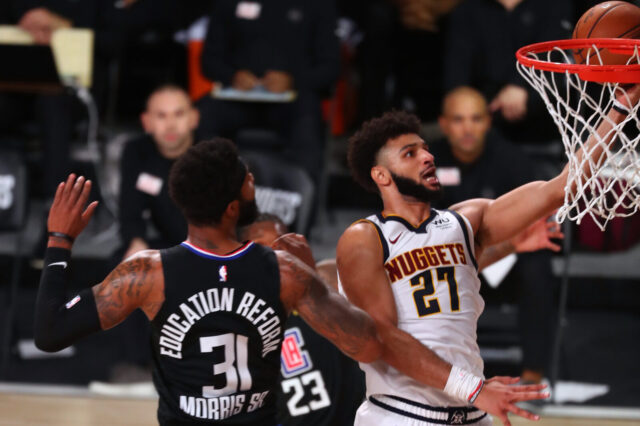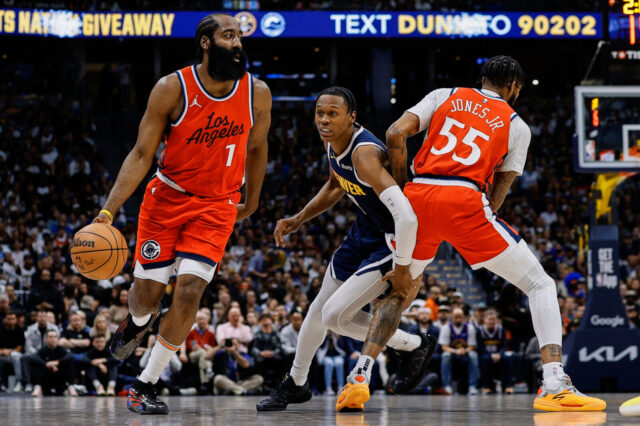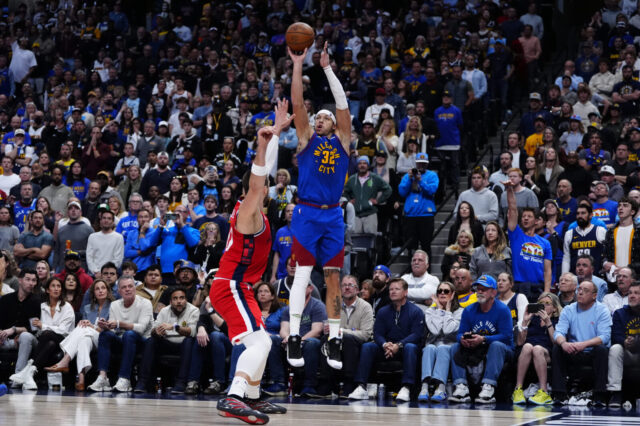Jamal Murray losing his man off-ball
The San Antonio Spurs had only been held to 101 points or less a total of 14 times throughout the regular season. 13 of those games, including two against the Denver Nuggets, resulted in Spurs losses. So you’d be hard pressed to nitpick what the Nuggets did defensively. Will Barton held DeMar DeRozan to just 2-11 shooting when those two players shared the court. LaMarcus Aldridge shot just 5-15 when Nikola Jokic was on the court.
Jamal Murray had a career-high six steals in game one and had plenty of impressive moments but in the playoffs, every mental lapse lowers your team’s chances of winning and Murray had a few high-profile lapses that led directly to easy baskets. The first and most egregious one occurred on one of the first possessions of the game when Murray got caught on his heels watching the ball, allowing Bryn Forbes to step into an open, rhythm three-pointer.
These shots are crucial for spot-up shooters to establish rhythm and confidence, especially role players like Forbes who finished the game shooting 3-4 from behind the arc.
Murray containing dribble penetration
Murray also struggled to stay in front on drives, especially when he was forced to close out and chase his man off of the three-point line.
The Spurs scored 11 of their 101 points in the five clips above, nearly 1/9 of their total, and each of them was preventable with a bit more urgency and attention to detail.
Attacking the PnR
The Spurs dropped their big deep into the paint on most pick-and-rolls (PnRs) and used their guards to fight hard around screens and contest from behind. When the Nuggets’ ball-handlers were able to turn the corner on the screen they found a wide open mid-range pull-up available. The mid-range pull-up isn’t the most efficient shot in basketball but the Nuggets can’t be afraid to take these shots when the defense allows the shooter to comfortably step into the shot.
Denver’s guards started to figure this out more and more as the game went on and I wouldn’t be surprised if the team shot a lot more of these types of shots in game two. Sometimes seeing a few mid-range shots go in can help establish a rhythm or force the defense to over-extend.
However, just like with three-point shots, the Nuggets can’t fall in love with the mid-range game. The Spurs defense is designed to lure teams into settling, and there is a big difference between taking open shots and settling for jumpers.
Attacking the rim
The Spurs don’t feature an elite athlete at the center position and as a team they only blocked 4.7 shots per 100 possessions in the regular season, good for 21st in the league, on par with the Denver Nuggets. Yet they still managed to allow opponents to attempt the 3rd fewest shots from 0-3 feet, according to basketball reference. They do this by playing positional defense and tricking offenses into settling for floaters and slightly more difficult shots just outside of the restricted area. What they lack in rim protection they make up for collectively with rim deterrence.
In the 4th quarter, when it was clear that the Nuggets just didn’t have their three-point shot going, Gary Harris started putting his head down and attacking the basket. His success on these drives provides a blueprint for the Nuggets in game two: get to the rim and elevate. Aldridge and Jakob Poeltl are not Rudy Gobert. They will try to take charges on out-of-control drives and will use their length and verticality to force tough finishes but the have to be challenged.
The short roll
Murray has been inconsistent delivering the ball to the short roll on target throughout the season but he can take a page out of Monte Morris’s book by stealing simple setup moves like the one below. Morris gets Patty Mills to jump his right hand with a quick crossover move then delivers the ball right on target to a rolling Mason Plumlee. Whether it’s Jokic or Plumlee, once the ball reaches the big at the center of the court the Nuggets are going to score.
Nikola Jokic in transition
Much has been made about Jokic’s low-scoring playoff debut with most of the conversation centering around whether or not he needs to be more aggressive looking for his shot. At practice on Monday, head coach Michael Malone seemed content with Jokic’s shot selection and was more focused on what the team could do to prevent and/or work around the double team.
“Look to post Nikola up early because they double team him every time,” Malone told the media. “In transition, it’s a lot harder to double team and execute your game plan.”
According to nba.com, the Nuggets did not score a single fast break point but Jokic did have this basket off of an offensive rebound in transition.
Spinning baseline
In the clip above, Jokic does another thing that might be the key to punishing the Spurs for the way that they send a second defender in the post every time that he caught the ball: spin toward the baseline. Spinning baseline, especially when it is done quickly after catching the entry pass, can draw the defender a step or two deeper into help and further away from recovery on the kickout. Send the help too slow and Jokic can spin back toward the paint for a jump hook or power his way toward the rim with a drop step. Send the help right away and the extra couple of steps forces the help defender to close out a bit further once he recovers back to his man.
Jokic’s timing on kickout passes
Jokic has Bruce Lee reaction speed when it comes to reading the helper trying to dig down in the post one pass away. Just look at how many of these passes come at the exact instant that the help defender leans toward the double team. Jokic is a counter-puncher by nature. Like a boxer sticking his chin out to tempt his opponent into a wild swing, Jokic likes to make moves that are more designed to draw a foolish stunt than to score the basket.
Falling into the trap
The Nuggets shot just six of 28 from the three-point line in game one, their 4th worst single game three-point percentage in 83 outings this season. Simply put, the Nuggets got the looks they wanted but they simply didn’t go in. However, the real success of the Spurs’ double team strategy wasn’t necessarily that the Nuggets missed an ungodly amount of shots. The team could progress to the mean in game two and San Antonio’s strategy of doubling Jokic might end in a blowout in Denver’s favor.
The real benefit of doubling Jokic early and often is that it took it him out of rhythm. There was probably only four or five times throughout the entire game that Jokic passed up scoring opportunities but they all came in the 3rd and 4th quarters after the Spurs had established the expectation of the fast double.
Whether Jokic was anticipating a double team that never came or whether he just lost his own rhythm as a result of the Spurs’ insisting that he take as few field goal attempts as possible, the 2nd half of game one saw Jokic misread a few golden opportunities to put pressure on the rim and score inside.
The crowd of over 17,000 Nuggets fans let out a collective groan on a couple of these post touches in which Jokic never even looked at the rim. Basketball is a rhythm game. In the same way that Bryn Forbes knocking down an easy shot early probably gave him confidence and rhythm, Jokic being forced to pass out of a double team so often probably disrupted his own rhythm and timing as a low post scorer.
Patience after the kickout
The other Nuggets can also do a better job of taking advantage of the kickouts that Jokic generates on these doubles. Most kickout passes don’t lead directly to a spot-up shot but a double-team inherently means that the defense will be at a disadvantage once the offense passes out of the trap. With two defenders tied to Jokic in the post, the race is on to find the open man and press the advantage.
Only this race requires both speed and patience. In the clip below, the ball flies around the arc before finding a pair of mismatches to exploit. Even better, the Nuggets don’t target the mismatch by trying to force-feed an isolation or post-up, another action that can be double teamed. Instead, the team works to find their spots around the court and put pressure on the rim through another drive to the basket and kickout. This is the blueprint to beating the double team. Three-point shooting can be up and down but at their best, the Nuggets work as a five-man unit to press an advantage.
Jokic doing work early in the post
At practice, Malone mentioned Jokic’s defense on Aldridge as one of the things that stood out when rewatching the film from game one.
“Nikola’s defense on Aldridge, I thought was terrific. He was physical, he did his work early, he made him a little bit uncomfortable.”
In the clip below, you can see exactly what Malone means about getting physical and doing work early. Aldridge is a finesse player who beats his man by getting to his spots. It’s all over once he turns the corner going right or gets you on your heels when he turns to his left. Jokic, a finesse player himself, did a great of walling off those spots on the court and forcing Aldridge further away from the paint before the ball dumps inside, when much less contact is allowed.
Millsap vs. Bertans
One battleground that could very well determine the outcome of a game or two in this series is the 2nd (and sometimes 4th) quarter matchup between Davis Bertans and Paul Millsap. For the Spurs, Bertans spaces the floor, preventing Millsap from providing as much backside help on drives and rolls to the basket as the Nuggets would like. For the Nuggets, Millsap is too strong and too quick for Bertans to guard one-on-one. In game one, Millsap was at his most aggressive in these stints, attacking off of the dribble and generating contact going toward the basket.
Rear contests
In order to contain a PnR, a big defending the ball screen has to prevent the ball-handler from getting too deep into the paint while the guard fights through the screen to recover. The Nuggets have been pretty good at keeping the ball-handler out of the restricted area but have been abysmal all season at fighting through screens and contesting pull-up jumpers from behind on PnRs.
DeMar DeRozan is probably the best high-volume mid-range pull-up scorer in the NBA. This will create a vulnerability in Denver’s defensive tendencies unless they can find a way to provide the same effort throughout the series contesting shots from behind as they did in game one. Defensive plays like this were a large part of why DeRozan scored just 18 points on 17 shots.
Belinelli rooks Beasley
Malik Beasley still has a lot to learn about defending shooters through off-ball screens. In the clip below, the veteran Marco Belinelli sends Beasley on a tour around Aldridge and Plumlee before pump-faking him out of bounds. Notice the subtle shove-off, the fake that sends Beasley running around the screen, the fade to the corner, and the Belinelli special: that exaggerated shot fake that is line one of Denver’s scouting report on him.
Take notes young blood. Someday you’ll be teaching 20-year old players these same lessons.
Patty Mills trying hard to give Jokic fouls
The Spurs are going to try to place Jokic in foul trouble through any means necessary. In the first quarter of game one, Mills hit the deck or whipped his head back every time he ran around a Nikola Jokic screen. Just look how convincing Mills is! Even the broadcast crew is initially appalled by the “crusher screen,” even letting out a gasp of concern for poor Mills.
On second watch…nice try Mills. And nice work by the officials to see these flops for what they were.


